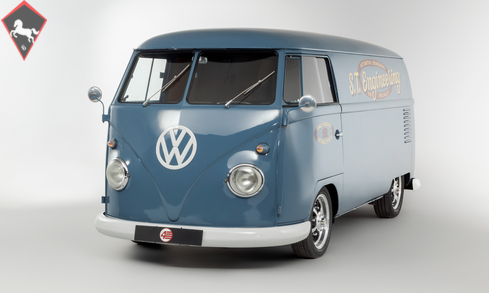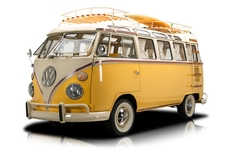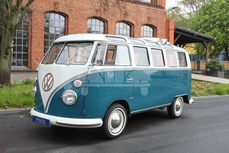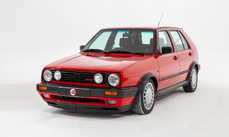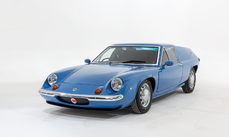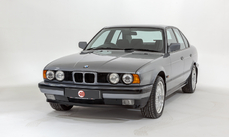Volkswagen Typ 2 (pre 1967) Split Bulli Panel Van 1960
Allgemeine Beschreibung :
Model History
The origin of the VW Type II bus began just after World War II in the VW factory in Wolfsburg, Germany. In 1947, a Dutch importer called Ben Pon, noticed that the motorised trolleys used to transport parts around the factory were made from stripped down Beetle chassis and running gear. He was inspired by these rather strange looking vehicles to sketch a design of a beetle-based van. A year later, the new chief executive of Volkswagen saw potential in this idea and the first VW van was officially launched at the Geneva Motor Show in November 1949. It was known as the Type II because it was the second VW model after the Beetle, the Type I.
By March 1950, ten vehicles a day were being produced. For the next four decades, the basic design remained the same and around five million buses were produced over that time. The Type II with its rear engine and ‘box on wheels’ body, filled a much-needed gap in the market providing a simple but sturdy vehicle that was flexible when it came to transportation but without a high degree of cost.
The unique design of the VW transporter meant that the rear seats could be removed in order to transport greater loads. As the design was so uncomplicated, VW was able to turn out 90 different body combinations over the first five years. These variations included buses, pick-ups, fire engines, ambulances, beer wagons, refrigerated ice-cream vans, milk floats, bread vans, mobile grocers, ordinary delivery vans and the well known and loved camper.
From 1949 until 1967, Volkswagen produced the first generation of VW buses in the form of split screens. These “splitties” earned their name due to the split windscreen and they also sported a sweeping v-line front. Their rear air-cooled flat 4 engine was simple and reliable.
Equipment
Dove Blue paintwork, Hand-painted VW specialist signwriting, Grey leatherette front seats, 2110cc flat 4 engine, 4-speed manual gearbox, Side loading doors, Walk-through rear cabin, Handmade cabinetry, Rear bench seat, Ply-lining, Alpine radio head unit, Britax picnic set, Twin-burner stove, Front brake discs, Larger rear brake drums.
Exterior
This amazing split-screen panel van has been owned by ST Engineering for the last 13 years and has been kept as a display piece in their showroom to show-off the quality of their work. The owner of ST Engineering is a true VW fanatic and searched long and hard to find this example, an ex-California van in amazing rust-free condition. Other than the company sign writing done by an old school craftsman – using traditional paints and gold leaf – the van has not required any paintwork in the current owner’s 13-year ownership, which is a true testament to the quality and structure of this example.
On closer inspection the body is completely free from any signs of corrosion or previous poor repairs, the panel gaps are first-rate and the van is incredibly straight down both sides. Being really critical there are probably five or six stone chips to the front end but other than that it’s totally unmarked. All of the chrome work is in fantastic original condition with only a tiny amount of patina on the handle on the rear side doors. Both bumpers are pristine, there are no cracks or chips to any of the light lenses, and the rubber seals around the windscreens and doors are in perfect condition. Tucked behind the rear bumper there is a fold out towbar that’s perfect for a bike rack or small camping trailer.
VIEWINGS WELCOME BY APPOINTMENT ONLY /// ADDITIONAL PHOTOS AVAILABLE UPON REQUEST
Interior
Starting up-front, the dashboard is in perfect condition and has never had any aftermarket gauges or instruments cut into it, so remains without a fuel gauge! The original steering wheel is also in lovely order with only a couple of very light cracks starting; the gear knob is perfect as is the front rubber mat and door cards. The only non-standard additions are an Alpine head unit mounted below the dash and a couple of 6x9 speakers in the doors. This example benefits from a walk-through cabin allowing you to access the rear of the van without getting out and potentially rained on. The vinyl seats themselves are in great condition with only a few small marks as seen on the base of the driver’s seat.
Moving into the back of the van the current owner has had some beautiful 60s-style cabinetry hand made with plenty of storage for all the camping equipment and paraphernalia you might want on a weekend away. The unit behind the passenger seat houses a small gas bottle for the Propex heater, an 810 amp leisure battery and an original Britax picnic set. The lift-up lid folds to reveal space for the new owner to fit a twin-burning stove. The fabric on the seats is very cool, beautifully tailored and in first-rate condition. All of the ply on the roof and in the side panels is in great order too, and the two wires poking out of the side panel between the seats are ready for the new owner’s choice of light. The rock ‘n’ roll bed works well with further storage beneath.
ENGINE & TRANSMISSION
Looking inside the engine bay all of the Dove Blue paintwork is immaculate with no signs of corrosion or any previous poor repairs. The motor itself is a 2110cc – a massive upgrade over the standard 1600cc unit – and it features 92mm pistons and a long 82mm stroke camshaft. This provides masses of low-down torque and makes for comfortable motorway cruising.
WHEELS, TYRES & BRAKES
The Flat4 GTV alloys suit the van perfectly and are in pristine condition with no curb marks or lacquer peel. The front Yokohama tyres are brand new and the matching rears have only driven a few hundred miles. On a service earlier this year the brakes were gone through and so are in fine working condition. On the front it has CSP discs and the rear benefits from larger drums from a VW Type 3 variant.
History File
This 1960 example started life in California, then headed for a period in Jersey before being imported by the current owner and coming to the UK in 2009. For the last 13 years the van has spent most of its life as a showpiece in the ST Engineering showroom with a few trips out and a couple of camping holidays. The owner is now selling the business hence why the van is also up for sale. ST Engineering have given it a full inspection and service ready for the new keeper’s peace of mind.
The accompanying History File contains the V5C showing just 1 UK owner, MOT certificates since being in the UK, all of the import paperwork, and a six-page spread in Volkswagen Camper magazine.
http://www.4starclassics.com/for-sale/vw-splitscreen-panel-van-for-sale/
1960 Volkswagen Typ 2 (pre 1967) Split Bulli Panel Van is listed verkauft on ClassicDigest in Kingsley by 4 Star Classics for £34995.
Fakten der Auto
Karosserietyp : Auto Marke : Volkswagen Modell : Typ 2 (pre 1967) Split Bulli Ausführung : Panel Van Hubraum : 2.1 Modelljahr : 1960 Karosstyp : Lieferwagen Lage : Hampshire
Verkauft
Angaben Zum Verkäufer
Verkauft
People who viewed this Volkswagen Typ 2 (pre 1967) Split Bulli also viewed similar Volkswagen listed at ClassicDigest
Other cars listed for sale by this dealer
über Volkswagen
Die Volkswagen-Geschichte ist in der Tat eine faszinierende Geschichte von Innovation, Belastbarkeit und Wiederbelebung nach dem Krieg, die von verschiedenen Modellen gekennzeichnet ist, die in der Automobilgeschichte zu Ikone geworden sind.Das Volksauto (Volkswagen): Zunächst von Adolf Hitler in den 1930er Jahren als "Volksauto" oder "Volkswagen" auf Deutsch vorgestellt, war die Idee, ein erschwingliches und praktisches Fahrzeug für das deutsche Volk zu schaffen. Dieses Konzept führte zur Entwicklung des von Ferdinand Porsche entworfenen Volkswagenkäfers (oder des Typ 1).
Nachkriegsherausforderungen: Nach dem Zweiten Weltkrieg stand Volkswagen erhebliche Herausforderungen. Die Fabrik war stark beschädigt, und die Verbindung der Marke mit dem NS -Regime führte in einigen Regionen zu einem mangelnden Interesse an dem Auto.
Britische Intervention - Die britische Armee & Ivan Hirst: Die britische Armee übernahm die Kontrolle über die Fabrik in der unmittelbaren Nachkriegszeit. Major Ivan Hirst, ein Offizier der britischen Armee, spielte eine entscheidende Rolle bei der Wiederbelebung von Volkswagen. Er erkannte das Potenzial des Käfers und setzte sich für seine Produktion ein. Er überzeugte das britische Militär, mehrere tausend Autos zu bestellen. Diese Entscheidung hat dazu beigetragen, die Wiederbelebung der Marke zu starten.
Exporterfolg und der globale Anziehungskraft des Käfers: Der Käfer gewann nicht nur in Deutschland, sondern auch weltweit an Popularität und wurde zu einer Ikone des erschwinglichen Fahrwerks. Das einfache, zuverlässige Design und das einzigartige Erscheinungsbild machten es zu einem Favoriten unter den Verbrauchern weltweit.
Modellentwicklung: Im Laufe der Jahre führte Volkswagen verschiedene Modelle neben dem Käfer ein, wobei jeder zum Wachstum der Marke beitrug:
Typ 2 (VW -Bus oder Transporter): In den 1950er Jahren wurde er in den 1960er Jahren zu einem ikonischen Symbol der Hippie -Bewegung eingeführt und wurde wegen seiner Geräumigkeit und Vielseitigkeit geliebt.
Golf (Kaninchen in den USA): Der Golf (oder Kaninchen in den USA) wurde Mitte der 1970er Jahre ins Leben gerufen und markierte eine Verlagerung in Richtung Frontantrieb, modernes Design und Schrägheckpraktikabilität und wurde zu einem Eckpfeiler des Erfolgs der Marke.
Passat, Jetta und andere Modelle: Volkswagen erweiterte seine Aufstellung mit Modellen wie dem Passat und Jetta, die sich für verschiedene Marktsegmente befassen.
Herausforderungen und Innovationen: Trotz des Erfolgs stand Volkswagen vor Herausforderungen, einschließlich Qualitätsproblemen in den 1970er Jahren. Die Marke hat jedoch weiterhin neue Modelle und Technologien entwickelt und entwickelt.
Aufstieg des GTI und globaler Expansion: In den 1980er Jahren stieg der legendäre Golf GTI auf, eine Hochleistungsversion, die den Trend der heißen Luke auslöste. Volkswagen erweiterte auch seine globale Präsenz in diesem Zeitraum.
Die britische Intervention bei der Wiederbelebung von Volkswagen nach dem Zweiten Weltkrieg spielte eine entscheidende Rolle bei der Wiederbelebung der Marke. Während es in den 1950er und 1960er Jahren aufgrund des Erfolgs von Volkswagen in den 1950er und 1960er Jahren möglicherweise einige Spannungen oder einen Wettbewerb zwischen Automobilunternehmen gegeben hat, hat die Fähigkeit der Marke, innovative und beliebte Modelle zu produzieren, ihren Platz in der Automobilgeschichte festigend.
